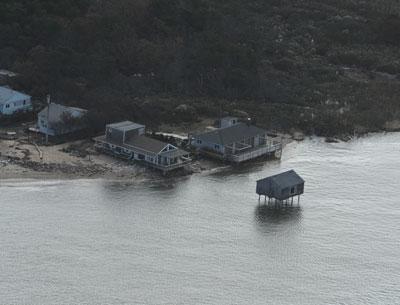Lazy Point Revetment Redux

For the second time this year, the East Hampton Zoning Board of Appeals on Nov. 13 began deliberating on an application from Christine Lemieux and Joshua Young to build a stone revetment to protect their bayfront property on Mulford Lane on Lazy Point.
The two bought the house on Gardiner’s Bay in 2010, despite the obvious danger to the property from the eroding coastline — 20 yards from their house is an eerie abandoned house, standing on pilings in the water. It was once a beachfront house.
In February, Ms. Lemieux and Mr. Young came before the board, requesting a series of variances to allow them to tear down the house and rebuild on their property, farther from the water, while also protecting it with a 150-foot-long stone revetment.
The board approved almost all the variances requested, but not those needed for the revetment.
Revetments are not permitted in that particular area of Napeague, the fear being the unintended consequences of such a structure, with tidal flow water being forced around the revetment, damaging adjacent shoreline and properties. According to a review of the couple’s latest proposal written in September by Brian Frank, the Town Planning Department’s chief environmental analyst, “bulkheads and revetments frequently have unanticipated environmental impacts. These impacts frequently extend beyond the footprint of the stricture, causing erosion and diminishing the quality of the natural resources on adjacent properties, as well.”
The vote against permitting the revetment was 4-1, with Don Cirillo being the lone dissenter. He argued, then, that the other variances were meaningless without the revetment, and that the board should not stand in the way of a homeowner who is willing to spend money on such a structure in order to protect their property.
Mr. Young and Ms. Lemieux apparently agreed with Mr. Cirillo’s assessment, holding off on construction while reconfiguring their plans for the revetment under the guidance of Laurie Wiltshire of Land Planning Services.
Ms. Wiltshire brought in D.B. Bennett, a consulting engineer, who reconfigured the revetment into a U-shape.
Mr. Bennett told the board at the Oct. 2 hearing for the new proposal, that the problem the couple was confronting had its roots in the dredging of the Napeague Harbor Inlet.
“According to town record 440,000 cubic yards of sand has been dredged out. It is our belief that taking that quantity of sand is causing these beaches [to lose sand, from east to west],” Mr. Bennett said.
“Over the last 57 years Mulford Lane has lost several houses,” he said, adding that the coastline erodes about 10 feet per year.
“It will take decades for the government to correct that. We’re not here for a short-term solution.”
Mr. Frank countered that the situation had not changed since the board’s earlier determination and that the town’s coastline was one of its most valuable assets.
The one major difference that all sides agree upon between now and the time of the March determination is that Ms. Wiltshire has obtained a permit for the revetment from the State Department of Environmental Conservation, a point not lost on Alex Walter, the board’s chairman.
“If you look at the pictures from [Hurricane] Sandy, and you saw where the water was, at the Young and Limeuix residence, it is a pretty frightening situation there. [This] is a better application, and has D.E.C. approval; it gives me pause,” Mr. Walter said.
“Water now is on their property. The town objects. The town should either buy their land or take it under imminent domain,” Mr. Cirillo said.
The recent storm, however, also created a counter-argument against the revetment which Mr. Walter brought up. “If that storm had come another 50 miles out, the revetment wouldn’t have saved the house,” he said.
He also pointed out that, during the storm, water had flooded the Mulford Lane area from the west. One of the fears expressed over this particular proposal is that it might exacerbate westward erosion and flooding.
Bryan Gosman, a board member, had visited the area after the storm, and recalled a conversation with a resident. She was adamant, he said, that until the dredging of the inlet is stopped, the erosion problems for the entire area will continue.
Lee White, a Z.B.A. member, explored the possibility of a solution that might have less of an environmental impact, such as canvas sand cubes, which break up over a period of years.
Mr. Walter was mindful that one board member, Sharon McCobb, was absent. “I know Sharon wants to weigh in here.”
Mr. Walter brought up the concept of “buyer beware,” an argument Ms. McCobb had made at the initial public hearing, early this year.
If you bought the house in 2010, he said, “you looked at the house out there on stilts, you’d say this is what’s going to happen here.”
Mr. Cirillo again argued that the town should either buy the land or allow owners to take appropriate measures to protect it.
“Our job is to get an application, consider the merits as it relates to the town code, and make a decision,” Mr. Walter said. “If everybody had to go exactly by the code, we wouldn’t have a job. We represent the Town of East Hampton to make the best decision for the town and the property owners.”
The board to agree to adjourn the debate until the next time all the members will be present, on Tuesday.
